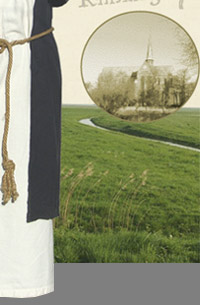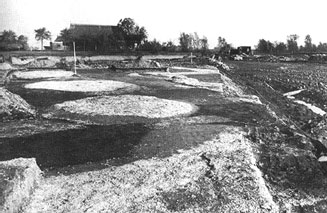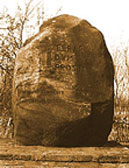 |
 |
Welcome
at the site about the monastry Klaarkamp
Fryslân, which has also been its official name since 1997, and is therefore also used in official Dutch language publications. Nowadays Friesland has 643,000 inhabitants (2005) and its capital is Leeuwarden (Ljouwert), with 91,817 inhabitants, in the center of the province. The river Dokkumer Ee swings through the meadow-land from Leeuwarden to Dokkum and makes a connection to the lake district of Fryslân and the area of Lauwerslake. A lot of little and big ships use this route; specially in the summer it is a dynamic picture. Travelling from Dokkum, at the eastside of this river, the road is almost as straight as an arrow. However, passing the few houses of the small village Sybrandahus, you will notice that there is a bend in the road. On the right side there are some farms, on the left side there is a rough grazing crossed by twisted ditches. It is hardly to imagine but these ditches were the moats of a large middle aged monastery that stood there for centuries ago: the monastery Klaarkamp. The abbots of the cloister corresponded with popes and kings. Not only for this reason the place was of great historic importance. In this region, Klaarkamp was the first monastery of the Cistercian Order and the monks of Klaarkamp were renowned for their hydraulic expertise and works. Even today, we can still see traces of this in the landscape. The monastery was builded around 1165 BC on a terp, in old cronicles named as Ringesheim. This terp was four meters in hight and it was as large as five football pitches. Probably two gates gave entrance to the cloister that was totally build according to Cistercian traditions. By the end of the middle-ages, in the region of the present provinces Friesland and Groningen, there were about fifty monasteries. During the Reformation, when catholic services were forbidden by the Frisian States, all monasteries were confiscated. They were closed and sold or pulled down as happened around 1580 for the buildings of monastery Klaarkamp. Since then, the site was in use as a public quarry. In a wide region the roman bricks were re-used in many buildings, not only in farmhouses nearby but also much farther, up to East Friesland. The last remains of the terp were digged off in the beginning of World War II. At the eleventh hour it was the renowned archeologist professor Albertus van Giffen who initiated research on the remains of the monastery. The foundations were mapped and some interesting findings were secured.
|
||||||
